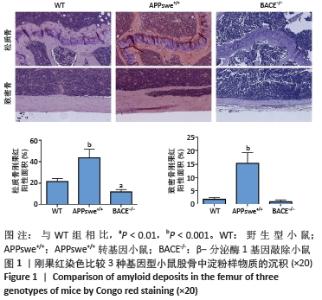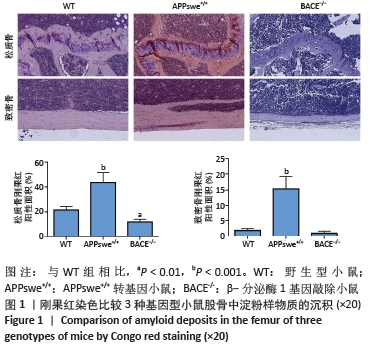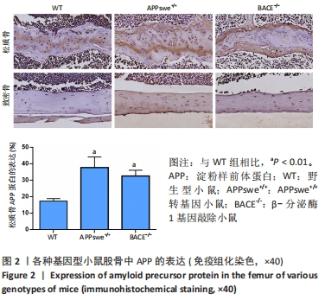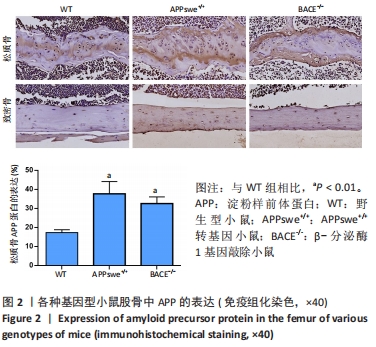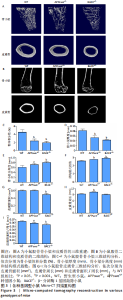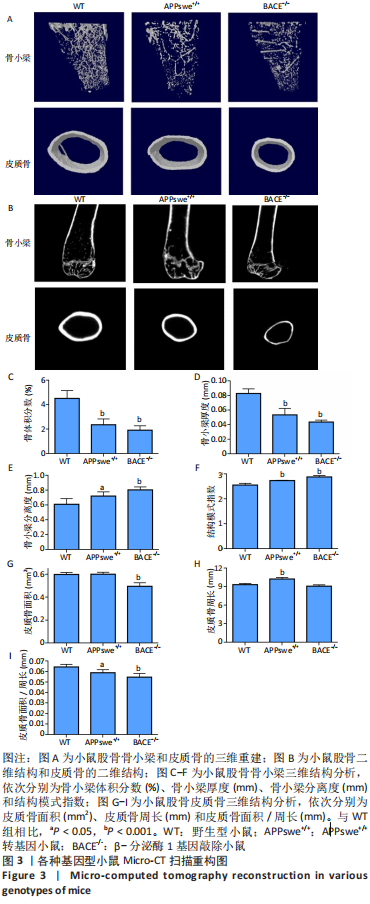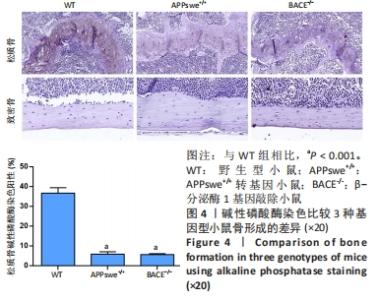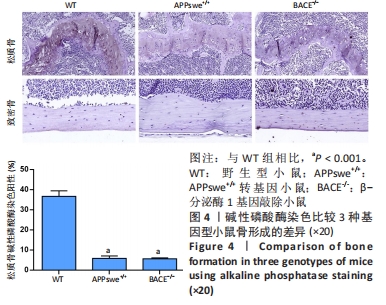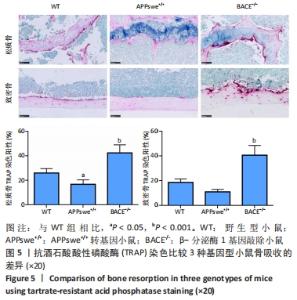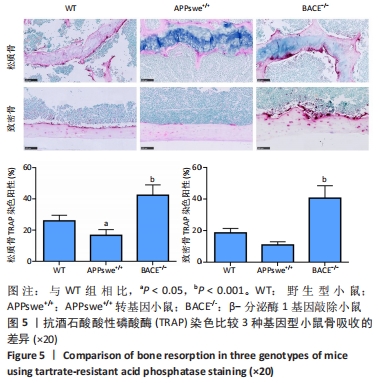Chinese Journal of Tissue Engineering Research ›› 2022, Vol. 26 ›› Issue (20): 3152-3157.doi: 10.12307/2022.613
Previous Articles Next Articles
Abnormally expressed beta-amyloid affects bone metabolism
Li Fangyu, Xia Wenfang, Cui Shun
- Union Hospital, Tongji Medical College, Huazhong University of Science and Technology, Wuhan 430000, Hubei Province, China
-
Received:2020-12-24Accepted:2021-03-03Online:2022-07-18Published:2022-01-18 -
Contact:Cui Shun, MD, Associate professor, Union Hospital, Tongji Medical College, Huazhong University of Science and Technology, Wuhan 430000, Hubei Province, China -
About author:Li Fangyu, Union Hospital, Tongji Medical College, Huazhong University of Science and Technology, Wuhan 430000, Hubei Province, China -
Supported by:the National Natural Science Foundation of China, No. 81671560 (to CS)
CLC Number:
Cite this article
Li Fangyu, Xia Wenfang, Cui Shun. Abnormally expressed beta-amyloid affects bone metabolism[J]. Chinese Journal of Tissue Engineering Research, 2022, 26(20): 3152-3157.
share this article
Add to citation manager EndNote|Reference Manager|ProCite|BibTeX|RefWorks
| [1] 孙红婷,宋艳荣. 楮实子提取物对APP /PS1小鼠学习记忆能力及对PI3K-C R EB-XBP1信号通路的影响[J]. 中国免疫学杂志,2019, 35(24):3021-3026. [2] PENNEY J, RALVENIUS WT, TSAI L. Modeling Alzheimer’s disease with iPSC-derived brain cells. Mol Psychiatry. 2020;25(1):148-167. [3] DENGLER-CRISH CM, ELEFTERIOU F. Shared mechanisms: osteoporosis and Alzheimer’s disease. 2019:1317-1318. [4] CUI S, XIONG F, HONG Y, et al. APPswe/Aβ regulation of osteoclast activation and RAGE expression in an age-dependent manner. Bone Miner Res. 2011;26(5):1084-1098. [5] XIA W, JUNG J, SHUN C, et al. Swedish mutant APP suppresses osteoblast differentiation and causes osteoporotic deficit, which are ameliorated by N-acetyl-L-cysteine. J Bone Miner Res. 2013;28(10): 2122-2135. [6] MCLEOD J, CURTIS N, LEWIS HD, et al. γ‐Secretase‐dependent cleavage of amyloid precursor protein regulates osteoblast behavior. FASEB J. 2009;23(9): 2942-2955. [7] LI S, LIU B, ZHANG L, et al. Amyloid beta peptide is elevated in osteoporotic bone tissues and enhances osteoclast function. Bone. 2014;61:164-175. [8] IMBIMBO BP, WATLING M. Investigational BACE inhibitors for the treatment of Alzheimer’s disease. Expert Opin Investig Drugs. 2019; 28(11):967-975. [9] TIWARI S, ATLURI V, KAUSHIK A, et al. Alzheimer’s disease: pathogenesis, diagnostics, and therapeutics. Int J Nanomedicine. 2019; 14:5541-5554. [10] BERA S, CAMBLOR-PERUJO S, CALLEJA BE, et al. AP-2 reduces amyloidogenesis by promoting BACE1 trafficking and degradation in neurons. EMBO Rep. 2020;21(6):e47954. [11] 邱伟, 连星烨. 唑来膦酸干预老年骨质疏松性股骨转子间骨折髋关节置换后患者骨密度、骨代谢标志物的2年随访[J]. 中国组织工程研究,2021,25(33):5265-5272. [12] MACÍAS I, ALCORTA-SEVILLANO N, RODRÍGUEZ CI, et al. Osteoporosis and the Potential of Cell-Based Therapeutic Strategies. Int J Mol Sci. 2020;21(5):1653. [13] ALZHEIMER’S ASSOCIATION. 2015 Alzheimer’s disease facts and figures. Alzheimers Dement. 2015;11(3):332-384. [14] DOWNEY CL, YOUNG A, BURTON EF, et al. Dementia and osteoporosis in a geriatric population: Is there a common link? World J Orthop. 2017;8(5):412. [15] STAPLEDON CJM, STAMENKOV R, CAPPAI R, et al. Relationships between the Bone Expression of Alzheimer’s Disease-Related Genes, Bone Remodelling Genes and Cortical Bone Structure in Neck of Femur Fracture. Calcif Tissue Int. 2021;108(5):610-621. [16] NGUYEN PH, RAMAMOORTHY A, SAHOO BR, et al. Amyloid Oligomers: A Joint Experimental/Computational Perspective on Alzheimer’s Disease, Parkinson’s Disease, Type II Diabetes, and Amyotrophic Lateral Sclerosis. Chem Rev. 2021;121(4):2545-2647. [17] OTZEN D, RIEK R. Functional Amyloids. 2019:11. [18] ROHER AE, ESH CL, KOKJOHN TA, et al. Amyloid beta peptides in human plasma and tissues and their significance for Alzheimer’s disease. Alzheimers Dement. 2009;5(1):18-29. [19] YANG B, LI S, CHEN Z, et al. Amyloid β peptide promotes bone formation by regulating Wnt/β‐catenin signaling and the OPG/RANKL/RANK system. FASEB J. 2020;34(3):3583-3593. [20] 李苗苗, 罗炯, 张庭然, 等. 骨质代谢与运动训练:骨重塑与骨细胞增殖[J]. 中国组织工程研究,2019,23(34):5544-5549. [21] LIU H, LUO T, TAN J, et al. ‘Osteoimmunology’ Offers New Perspectives for the Treatment of Pathological Bone Loss. Curr Pharm Des. 2017; 23(41):6272-6278. [22] NIE R, WU Z, NI J, et al. Porphyromonas gingivalis Infection Induces Amyloid-beta Accumulation in Monocytes/Macrophages. J Alzheimers Dis. 2019;72(2):479-494. [23] PARK EK, JUNG HS, YANG HI, et al. Optimized THP-1 differentiation is required for the detection of responses to weak stimuli. Inflamm Res. 2007;56(1):45-50. [24] LEE JW, NAM H, KIM LE, et al. TLR4 (toll-like receptor 4) activation suppresses autophagy through inhibition of FOXO3 and impairs phagocytic capacity of microglia. Autophagy. 2019;15(5):753-770. [25] JIN HK, BAE JS, FURUYA S, et al. Amyloid beta-derived neuroplasticity in bone marrow-derived mesenchymal stem cells is mediated by NPY and 5-HT2B receptors via ERK1/2 signalling pathways. Cell Prolif. 2009;42(5):571-586. [26] KORONYO-HAMAOUI M, SHEYN J, HAYDEN EY, et al. Peripherally derived angiotensin converting enzyme-enhanced macrophages alleviate Alzheimer-related disease. Brain. 2020;143(1):336-358. [27] SHIN BK, KANG S, KIM DS, et al. Intermittent fasting protects against the deterioration of cognitive function, energy metabolism and dyslipidemia in Alzheimer’s disease-induced estrogen deficient rats. Exp Biol Med (Maywood). 2018;243(4):334-343. [28] SIVAJI K, KANNAN RR, NANDHAGOPAL S, et al. Exogenous human beta amyloid peptide interferes osteogenesis through Sox9a in embryonic zebrafish. Mol Biol Rep. 2019;46(5):4975-4984. [29] DANIELS MJ, RIVERS-AUTY J, SCHILLING T, et al. Fenamate NSAIDs inhibit the NLRP3 inflammasome and protect against Alzheimer’s disease in rodent models. Nat Commun. 2016;7:12504. [30] WANG TH, JIANG Y, XIAO LP. Expression of amyloid beta-protein in bone tissue of APP/PS1 transgenic mouse. Zhonghua Yi Xue Za Zhi. 2013;93(1):65-68. [31] SPÄNI C, SUTER T, DERUNGS R, et al. Reduced beta-amyloid pathology in an APP transgenic mouse model of Alzheimer’s disease lacking functional B and T cells. Acta Neuropathol Commun. 2015;3:71. [32] CRUZ E, KUMAR S, YUAN L, et al. Intracellular amyloid beta expression leads to dysregulation of the mitogen-activated protein kinase and bone morphogenetic protein-2 signaling axis. PLoS One. 2018;13(2): e0191696. |
| [1] | Mi Jianguo, Qiao Rongqin, Liu Shaojin. Bushen Jianpi Huoxue Recipe improves bone metabolism, oxidative stress, and autophagy in osteoporotic rats [J]. Chinese Journal of Tissue Engineering Research, 2022, 26(26): 4147-4152. |
| [2] | Chen Qiaoling, Bai Yiguang, Liu Kang, Lin Tao, Luo Xuwei. Osteoblast differentiation after conditional knockout of 3-phosphoinositide-dependent protein kinase-1 gene from bone marrow mesenchymal stem cells [J]. Chinese Journal of Tissue Engineering Research, 2022, 26(24): 3785-3789. |
| [3] | He Xingpeng, Zheng Liqin, Li Pengfei, Yue Guiyang, Li Zhihong, Wu Minhui, Lin Ziling. Differences of trabecular microstructure and bone metabolism in two types of kidney-deficiency ovariectomized rats [J]. Chinese Journal of Tissue Engineering Research, 2022, 26(23): 3768-3772. |
| [4] | Wu Saixuan, Zhang Mi, Dong Ming, Lu Ying, Niu Weidong. Regulatory role of Keap1/Nrf2/ARE signaling pathway in bone homeostasis [J]. Chinese Journal of Tissue Engineering Research, 2022, 26(2): 271-275. |
| [5] | Zeng Xinyu, Chen Xianghe, Liu Bo, Lu Pengcheng, Jin Shengjie, Li Wenxiu, Tian Zhikai, Sun Changliang. Mechanism of exercise improving bone metabolism in type 2 diabetics mellitus based on "Muscle-Bone" Crosstalk [J]. Chinese Journal of Tissue Engineering Research, 2022, 26(2): 289-295. |
| [6] | Tian Xinbao, Xu Jianfeng, Huang Yuan, Lai Zheying, Li Xiaolong, Liu Xiaoli, Lin Ruizhu, Zhu Ning. Internal heat-type acupuncture inhibits osteoblast viability and promotes bone formation in a rat model of steroid-induced avascular necrosis of the femoral head [J]. Chinese Journal of Tissue Engineering Research, 2022, 26(17): 2642-2648. |
| [7] | Huo Hua, Liu Guanjuan, Song Na, Zhou Qian, Cheng Yuting, Luo Shanshan, Liao Jian. Effects of zoledronic acid on alveolar bone metabolism and nucleotide-binding oligomerization domain-like receptor protein 3 inflammasome in the alveolar bone of ovariectomized osteoporosis rats [J]. Chinese Journal of Tissue Engineering Research, 2022, 26(17): 2660-2666. |
| [8] | Lin Xiaosheng, Han Linjing, Wu Keliang, Zhang Zhen, Wang Hongbo, Xiao Qinghua, Du Genfa, Zhu Jianzong. Effects of Zishen Jiangu Recipe on bone microstructure and bone mineral density in ovariectomized rats with osteoporosis [J]. Chinese Journal of Tissue Engineering Research, 2022, 26(15): 2382-2386. |
| [9] | Li Chao, Zhang Xian, Shao Jiahao. Role of TRPV5 and TRPV6 calcium channels in bone metabolism [J]. Chinese Journal of Tissue Engineering Research, 2022, 26(12): 1950-1955. |
| [10] | Chen Jiming, Wu Xiaojing, Liu Tianfeng, Chen Haicong, Huang Chengshuo. Effects of silymarin on liver injury and bone metabolism induced by carbon tetrachloride in mice [J]. Chinese Journal of Tissue Engineering Research, 2021, 25(8): 1224-1228. |
| [11] | Zheng Xiaolong, He Xiaoming, Gong Shuidi, Pang Fengxiang, Yang Fan, He Wei, Liu Shaojun, Wei Qiushi. Bone turnover characteristics in patients with alcohol-induced osteonecrosis of the femoral head [J]. Chinese Journal of Tissue Engineering Research, 2021, 25(5): 657-661. |
| [12] | Wang Jing, Lang Xuemei, Wang Weiqun, Zhang Hanxiang, Zhang Yi, Wang Xin. Participation and regulatory mechanism of interleukin-1 during bone metabolism [J]. Chinese Journal of Tissue Engineering Research, 2021, 25(36): 5851-5858. |
| [13] | Qiu Wei, Lian Xingye. Effect of zoledronic acid on bone mineral density and bone metabolism markers in elderly patients with osteoporotic intertrochanteric fracture after hip arthroplasty: 2-year follow-up [J]. Chinese Journal of Tissue Engineering Research, 2021, 25(33): 5265-5272. |
| [14] | Lin Ruohui, Chen Sainan, Ye Yunjin, Chen Juan, Xie Lihua, Huang Jingwen, Ge Jirong, Li Shengqiang. Protective mechanism of Gushukang granule in a rat osteoporosis model based on TMT proteomic analysis [J]. Chinese Journal of Tissue Engineering Research, 2021, 25(32): 5141-5147. |
| [15] | Lai Honghui, Liu Yue, Li Tiyuan, Pan Xiaohua, Xu Zhongshi. Effect of exogenous hydrogen sulfide on bone metabolism in an ovariectomized osteoporotic rat model [J]. Chinese Journal of Tissue Engineering Research, 2021, 25(29): 4632-4637. |
| Viewed | ||||||
|
Full text |
|
|||||
|
Abstract |
|
|||||
